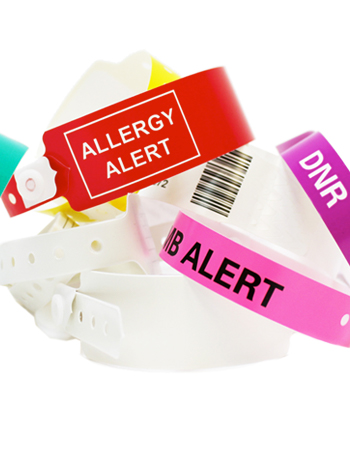Just How Patient Identification Band Boosts the Total Patient Experience in Health Centers
Just How Patient Identification Band Boosts the Total Patient Experience in Health Centers
Blog Article
Enhancing Safety And Security: The Significance of Person Identification Bands in Medical Care
In the world of healthcare, the efficacy of client recognition bands can not be overemphasized, as they function as an essential safeguard against misidentification and succeeding errors. These bands, commonly overlooked, contain important details that is vital for making certain client safety and security and optimal therapy results. Nonetheless, the application of effective identification protocols presents several difficulties that healthcare carriers have to browse. As we explore the complex duty of these bands, it becomes obvious that their importance expands beyond plain identification, questioning concerning ideal practices and future developments in patient security.
Introduction of Client Recognition Bands
Client recognition bands play a vital duty in making certain the safety and security and precision of person care in healthcare settings. These bands, usually endured the wrist or ankle joint, work as a crucial tool for verifying patient identification, therefore minimizing the threat of errors in therapy, medicine administration, and other health care procedures. Made from sturdy products, client identification bands typically include crucial details such as the client's name, date of birth, clinical document number, and barcodes or QR codes for scanning.
The implementation of client identification bands is essential in various medical care settings, consisting of medical facilities, outpatient centers, and long-lasting care establishments. They add to a systematic technique in client management, making it possible for healthcare specialists to rapidly and properly recognize individuals, especially in high-pressure circumstances where quick decision-making is vital.
Additionally, the usage of these bands is aligned with regulatory standards targeted at improving client safety - Patient Identification Band. By ensuring that each patient's details is quickly proven and easily easily accessible, doctor can preserve a high standard of treatment, reduce the incidence of unfavorable occasions, and foster a society of safety within health care institutions
Advantages of Accurate Identification
Precise identification is essential to enhancing client safety and care quality in health care setups. It acts as the very first line of defense versus mistakes that might lead to negative individual end results. By guaranteeing that each person is appropriately determined with trustworthy means, such as patient recognition bands, healthcare carriers can significantly lessen the risk of misidentification, which can bring about inappropriate treatments, medication errors, and also medical mix-ups.
Furthermore, exact person identification assists in efficient communication among healthcare groups. When all personnel can consistently recognize people, they can share critical information a lot more effectively, leading to far better control of care. This is specifically essential in emergency situations where prompt treatments are critical.
In addition, accurate recognition supports conformity with regulatory criteria, consequently reducing the threat of legal effects for medical care facilities. It cultivates depend on in between people and healthcare carriers, as clients really feel a lot more protected knowing that their identifications are being secured.

Typical Difficulties Encountered
Guaranteeing reliable person identification in medical care settings offers a series of obstacles that can jeopardize safety and care quality. One significant challenge is the variability in client populaces. Clients might show up in a state of confusion or distress, making accurate identification hard. Furthermore, language obstacles can hinder efficient communication, making complex the verification procedure.
Another obstacle is the dependence on human aspects in recognition procedures. Medical care professionals may accidentally overlook or misinterpret recognition protocols, especially in high-stress settings such as emergency departments. This can cause errors, including the management of wrong treatments or medicines.
Technical issues likewise pose obstacles. Although digital wellness record (EHR) systems are designed to streamline patient recognition, system interruptions Find Out More or user mistakes can interfere with the process. Moreover, the physical design of patient ID bands can lead to readability problems, especially in cases where bands are harmed or covered.
Last but not least, inconsistent training among personnel relating to identification protocols can cause gaps in understanding and method. Resolving these challenges is critical for enhancing client safety and security and making certain that recognition bands offer their intended objective efficiently.
Ideal Practices for Application
To properly carry out patient identification bands in healthcare setups, companies have to embrace a multifaceted technique that prioritizes innovation, training, and standardization integration. Standardization includes establishing clear methods for the style, application, and use of recognition bands throughout all divisions. This makes sure consistency and decreases the threat of errors connected to differences in band kinds or identifying approaches.


Training is vital for all health care personnel to guarantee they recognize the value of accurate individual identification, how to correctly check out and use identification bands, and the treatments to comply with in case of inconsistencies. Normal workshops and refresher course programs can strengthen this knowledge and advertise a society of safety.
Technology integration plays a crucial role in enhancing the effectiveness of client recognition bands. Utilizing barcode scanning or RFID modern technology can enhance the identification procedure, enabling for real-time confirmation of patient identities. In addition, digital health record systems need to be configured to include informs for inequalities in between the identification band and individual information.
Future Trends in Client Safety
As health care remains to evolve, the focus on client safety and security is most likely to magnify, driven by developments in technology and a greater understanding of systemic risks. Arising trends indicate a change in the direction of even more integrated systems that take advantage of data analytics, expert system, and artificial intelligence to enhance patient identification procedures. These innovations can aid identify prospective safety issues before they intensify, thereby lowering mistakes connected with misidentification.
Additionally, the implementation of blockchain technology may reinvent how patient data is safely shared like this amongst doctor, guaranteeing that identification bands are continually accurate and updated. This will certainly not only improve client safety and security but also help with smooth communication throughout multidisciplinary teams.

In enhancement, the growing concentrate on personalized medicine is expected to affect person security protocols. By incorporating demographic and hereditary details right into identification systems, medical care experts can tailor treatments extra effectively, reducing the risks of damaging reactions as a result of misidentification.
Verdict
In final thought, person recognition bands serve as a crucial part in boosting safety within healthcare settings. Inevitably, the continued emphasis on durable recognition methods will add to improved patient outcomes and total security in medical care settings.
In the world of medical care, the efficacy of patient recognition bands can not be overemphasized, as they serve as a basic guard versus misidentification and subsequent errors.Patient identification bands play a crucial role in making sure the safety and accuracy of client care in medical care settings. Made from sturdy products, individual identification bands frequently consist of vital details such as the individual's name, date of birth, medical record number, and barcodes or QR codes for scanning.
By making internet certain that each client is appropriately identified via trustworthy ways, such as client recognition bands, health care companies can significantly minimize the threat of misidentification, which can lead to unsuitable treatments, medication errors, and even medical mix-ups.
In conclusion, individual identification bands offer as a crucial part in improving safety within health care settings. Patient Identification Band.
Report this page